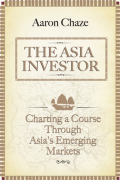
The current global financial crisis has changed the way the world looks at risk. Liquidity is constrained and low returns will be the norm for the next fewyears in all asset classes. Many Asian economies were very significant beneficiaries of large cross border capital flows in recent years, cheap credit and liberal leverage. Now that the era of liquidity and high risk tolerance is over, Asia will have to carry its share of the economic pain. Given that not all Asian economies will hurt equally, Aaron Chaze examines how investors can findtheir way around the pick of Asian economies in a low return environment. China and India, the twin pillars of Asia, cannot maintain their scorching pace of growth and growth rates have begun to drop as the pressures of deleveraging,risk containment and preference for saving over consumption over-takes these economies as it does the other world economies. The question is how much will growth drop especially as trade and export markets seize up and what will be the impact of declining growth in two of the most exciting markets in the world? India and China, the two fastest growing markets, however were not the only rising stars in Asia; Indonesia and the Philippines were also reporting a faster pace of growth driven by a mix of global demand for exports, rising commodity prices, expanding domestic incomes and rising domestic consumption and investment spending. The rising economic tide lifted all Asian boats, with only a few exceptions. Now that the tide is receding, do these Asian economies have the economic systems, corporate and political leadership and the companies, asset classes and markets that can not only survive but perform in this new and more demanding environment? The pain that the US is experiencing will not be asacute since Asian economies did not experience a real estate bubble financed with debt tied to household wealth the way the US did. Dubai and to some extent Abu Dhabi and Oman in the Middle East were probably the only Asian regions to undergo a recent real estate boom with bubble like conditions. But like the US Asian governments have been quick to demonstrate their financial flexibility in attempting to stabilize their economies and equally importantly their currencies. With this backdrop the book looks at the sectors that have the best potential to perform and for the conditions needed in order for Asia to resume its growth. In the ten years since the Asian banking and currency crisis therehave been several key and significant developments in Asia that make it a compelling story investors should pay attention to. For nearly this entire decademany Asian economies have witnessed steadily rising income levels, rising domestic investment, growing base of minority investors, growing institutional investor interest, increased sophistication of financial markets including the development of a liquid bond market, stable currencies and monetary policies and unprecedented fiscal flexibility with governments. Three other powerful trends are the rising levels of co-operation among Asian economies, demographics that favor growth and the emergence of Asian sovereign funds that are increasingly catalyzing the investment canvas. The Emirate of Abu Dhabi has the worlds largest sovereign fund and the Middle East along with the Chinese and Singaporean funds could hold the key to Asian and global revival. We are probably witnessing the emergence of a new breed of lenders of last resort and deep pocketed investors. Aaron Chaze also evaluates the emergence of the Asian bond marketas a recognized force in global finance. Since the Asian currency and bankingcrisis in 1997 a stable and growing market has emerged for local currency denominated Asian bonds. The market (ex-Japan) has been measured at $43 trillion.With the weakening of the US dollar and the credit uncertainty in the US and Europe there is an even better platform for the Asian bond market to develop.
- ISBN: 978-0-470-82529-7
- Editorial: John Wiley & Sons
- Encuadernacion: Cartoné
- Páginas: 250
- Fecha Publicación: 20/08/2010
- Nº Volúmenes: 1
- Idioma: Inglés
